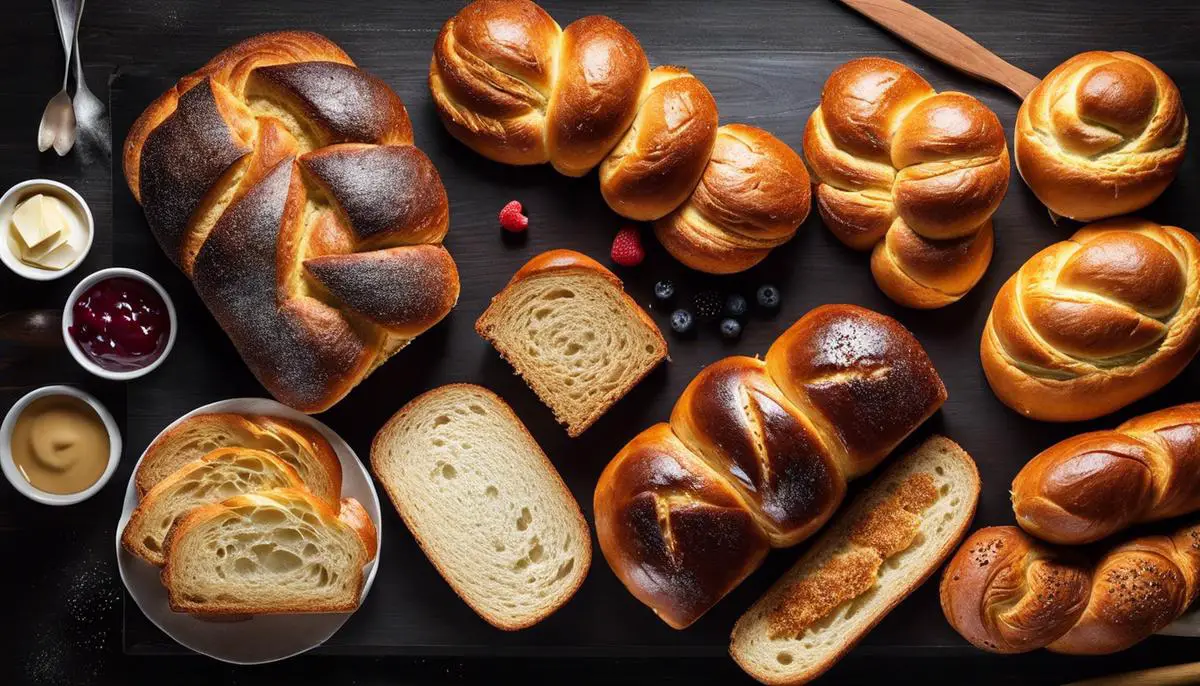
There are few pleasures in the culinary world that rival the comfort and delight evoked by a beautifully prepared plate of French toast. Its humble beginnings, rooted in the tradition of transforming stale bread into a sumptuous meal, have given way to a dish celebrated in diners and gourmet kitchens alike. The secret to mastering the art of French toast begins with selecting the ideal bread—robust enough to soak up the rich, spiced custard without falling apart, yet delicate enough to yield a delectably tender bite. Whether it is the buttery brioche, the braided beauty of challah, or a substantial slice of classic white bread, the foundation you choose sets the stage for a culinary experience that is both satisfying and versatile.
Choosing The Right Bread
Unlocking the Secret to the Ultimate French Toast Bread
When it comes to whipping up a batch of irresistible French toast, picking the right type of bread is like choosing the perfect canvas for a masterpiece. It’s not just a background player; it’s an essential ingredient that can take your French toast from just okay to oh-la-la!
So, what should you look for in the perfect French toast bread? First off, aim for something sturdy. You don’t want a slice that falls apart the second it meets the egg mixture. Challah and brioche are like the VIPs of French toast bread. They’re rich, buttery, and they soak up the egg mix like a sponge without getting all soggy.
Next, let’s talk about age. No, not your age – the bread’s! Day-old bread is the secret ingredient here. Fresh bread might be good for sandwiches, but it’s too soft for French toast. When bread takes a little time to sit out, it becomes just dry enough to absorb all that eggy goodness without turning into mush.
Now, thickness is key! Picture this: a thin, wimpy slice of bread versus a thick, hearty one. Which one do you think can handle all the delicious toppings and syrup without turning into a floppy mess? That’s right! Thick slices are what you want. Cut your bread about an inch thick—this gives it enough heft to hold up to the egg mixture and cook evenly.
Finally, let’s talk about flavor. After all, you’re a culinary adventurer who savors every bite! You want a bread that has its own character but doesn’t overwhelm the subtle dance of cinnamon, vanilla, and maple that makes French toast so divine. That’s why challah and brioche, with their slightly sweet profiles, are winners. But there’s no harm in trying different types of bread! Sourdough adds a nice tang, and whole wheat gives a nutty depth. Mix it up, and find your personal favorite.
Making French toast is like creating edible art, and the bread you use sets the stage. Remember these tips: sturdy, slightly aged, thick, and flavorful, and you’ll be well on your way to making the kind of French toast that dreams are made of. So grab your skillet, and let the sizzle lead the way to a sensational start to your day!
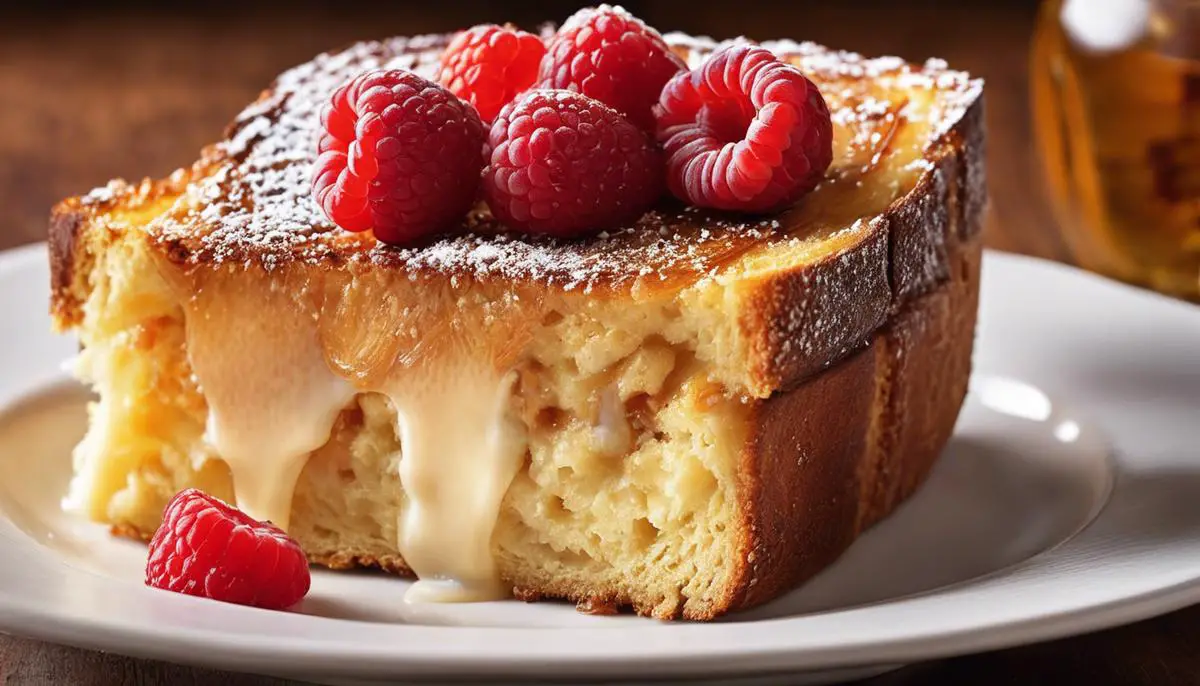
The Perfect Custard Mixture
Alright folks, now that we’ve got the bread situation squared away, let’s talk about what truly makes French toast an unforgettable breakfast: the custard. So how does one elevate their custard to be a flavorful, drool-worthy mixture? Listen up, because the secret lies in the ingredients and technique!
First off, we’re talking eggs – they’re the backbone of the custard. Don’t skimp on them, because they bring the richness and color to the party. Whisk them up nice and good until they’re silky smooth and begging to be joined by the rest of the ingredients.
Next, the milk. Full-fat is the way to go – it’s French toast, not toast on a diet, after all. But hey, if you’re feeling frisky, why not swap some of that milk out for a bit of cream? Or, dare to be different with almond or coconut milk for a twist on the classic. The choice is yours, and it’s a delicious one to make.
Now we sweeten the deal. White sugar? Sure, it’s a classic. But have you ever tried brown sugar, honey, or even maple syrup right there in the mix? They bring a whole new depth of flavor that’ll make your taste buds do the cha-cha.
Spice it up a notch, why don’t ya? Cinnamon and nutmeg are the dynamic duo of French toast spices, but no one’s stopping you from getting creative. Cardamom, cloves, or even a pinch of ground ginger might just become your new best friends.
Vanilla extract whispers sweet nothings into your custard, giving it a warm, comforting aroma that’s bound to wake up everyone in the house. Just a splash will do. And if you’re feeling extra, a scrape from a vanilla bean can really take things up a notch.
Once you’ve got these components together, whisk it like your French toast’s life depends on it, making sure everything’s blended into a smooth, loving mixture. Then, here comes your golden ticket: the soak. Let that bread bathe in your custard like it’s in a five-star spa, getting all cozy and saturated. But, like picking the perfect outfit, don’t rush this step or the bread will fall apart, and that’s no good for anyone.
Now, you’re armed with the secrets to a custard that brings joy, comfort, and a little bit of show-off to your kitchen table. Go on, be fearless and make that French toast sing.
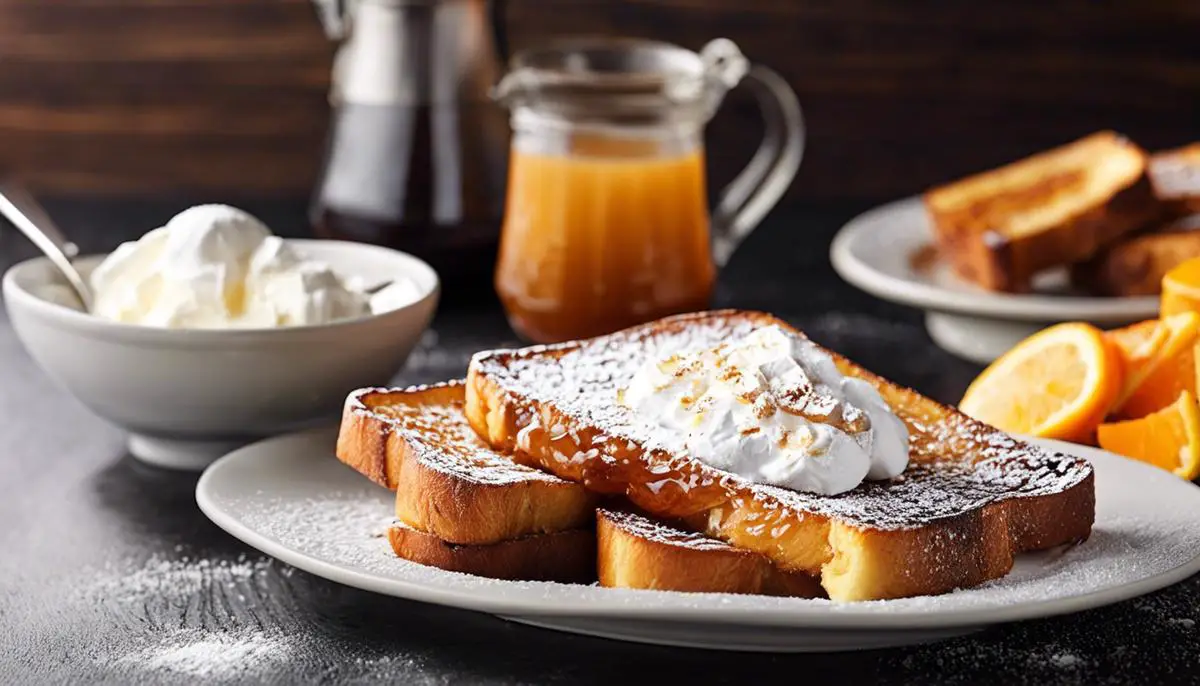
Cooking Techniques & Toppings
Moving on from the absolute basics, let’s dive into the nitty-gritty of what makes a truly scrumptious French toast. After all, it’s the skillful application of heat that turns that beautifully soaked bread into a mouthwatering dish.
Heat matters. Get your pan just right – ideally a non-stick skillet or a well-seasoned cast iron. Medium heat is the sweet spot; it’s hot enough to cook the toast through and give it that gorgeous golden-brown crust, but it’s not so hot that it burns. Nobody wants a charred toast!
Now, let’s talk oil versus butter. For those in the know, butter is the key to flavor-town. It browns nicely and gives a rich, nutty flavor that complements the sweetness of our custard-soaked slices. But be cautious – if the pan is too hot, butter burns. You can mix a little oil with the butter to raise the burning point if needed. It’s like having the best of both worlds.
When it’s time to cook, don’t rush it. Let the bread swim a bit in the custard, then allow excess to drip off – you want it soaked, not soggy. And when it hits the pan, give it space. Crowding the pan is a big no-no, friends. Each slice needs room to breathe, to cook evenly, to become that perfect French toast. Flip it only once. Yes, once. Cooking is not a toaster oven affair; patience is your ally here. Cook until each side is perfectly caramelized.
But what after cooking? Resting is just as important as the cooking. Think of it like a good steak – give it a minute before you dig in. It lets the flavors settle, the crust firm up just a tad. Mmm, now that’s a piece of French toast worth eating.
Last but not least, the toppings are not just toppings – they’re crowning glories. Fresh berries, a dollop of whipped cream, a sprinkle of powdered sugar, or a generous drizzle of real maple syrup – they can turn a good French toast into an unforgettable breakfast. Get creative. Make a compote if the heart says so, or maybe some candied pecans for crunch.
Remember, making French toast is not merely cooking; it’s an art that you paint with flavors and textures. With these tips, go forth and whip up a French toast that can make tastebuds dance!
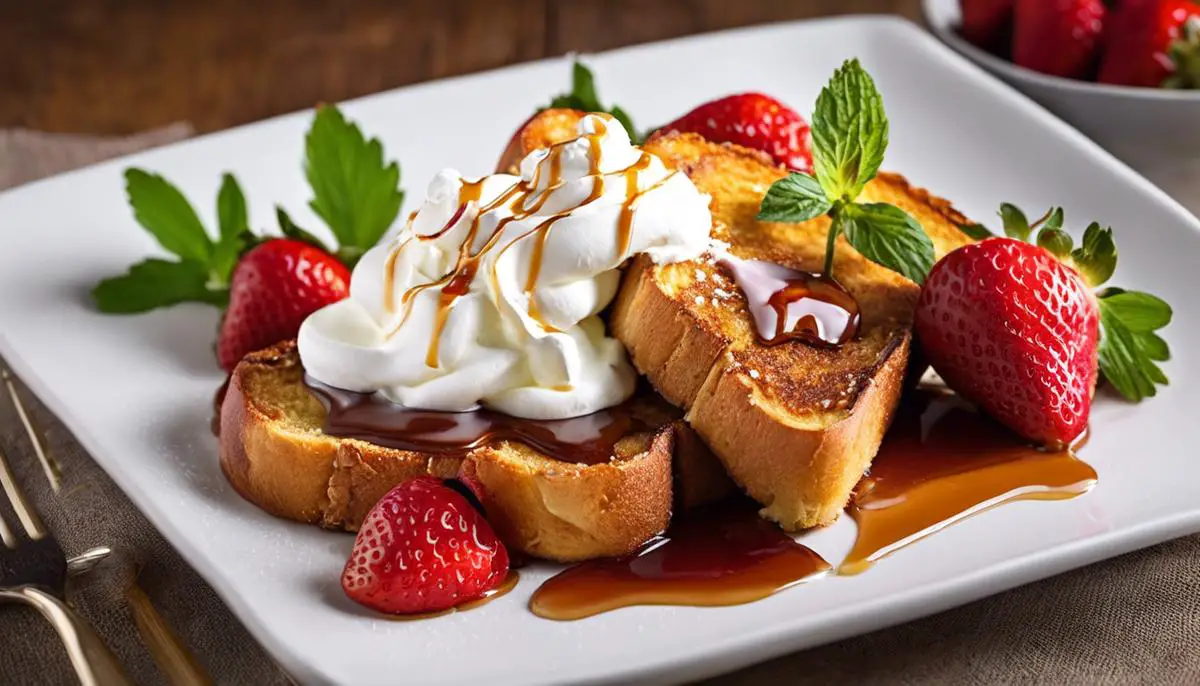
Serving Suggestions & Pairings
Now that we’ve tackled the bread, custard, and the perfect sizzle in the pan, let’s dive into the creative playground of serving and pairing French toast that’ll transform your brunch experience into something extraordinary!
Creative Toppings and Add-Ons
Of course, the usual suspects like powdered sugar, maple syrup, and a pat of butter make for a dreamy French toast, but why not take a walk on the wild side? Drizzle some homemade caramel, dollop a spoonful of lemon curd, or scatter a handful of toasted coconut flakes on top for a texture and flavor fiesta.
Pair with Fresh Fruit
Nothing beats the succulence of fresh fruit atop a warm slice of French toast. Whether it’s a berry medley, sautéed apples, or a tropical twist with mango and pineapple, the freshness immediately elevates the dish. Plus, a sprig of fresh mint will not only make the plate pop with color but will add a refreshing zing.
Go Nuts for Nuts
Nuts offer a satisfying crunch and nuttiness that complements the softness of French toast. Pecans, walnuts, slivered almonds, or even a sprinkle of toasted sesame seeds can add a whole new dimension to your breakfast masterpiece.
Indulge in Creaminess
A scoop of whipped cream, a quenelle of mascarpone, or a spoon of ricotta cheese enriches French toast like a warm hug. For those who love a little tang, a dollop of Greek yogurt works wonders, especially when drizzled with honey or a berry compote.
Savory Is the New Sweet
Who says French toast can only be sweet? Top with a fried egg, a slice of ham, or crispy bacon to enjoy a savory spin on the classic. Melt some cheese on top, and introduce a fresh tomato salsa or avocado slices for a sensational savory breakfast.
Perfect Pairings
And to wash it all down? A glass of freshly squeezed orange juice is fantastic, but for special occasions, why not sip on a mimosa or a crisp glass of white wine? If caffeine is what you crave, a robust coffee or a delicate tea pairs magnificently.
Sharing these works of edible art with friends is what life’s all about—a delightful plate of French toast becomes the canvas for connection and joy. So get those spatulas ready, let your imagination run free, and let’s make every breakfast a festival of flavors!
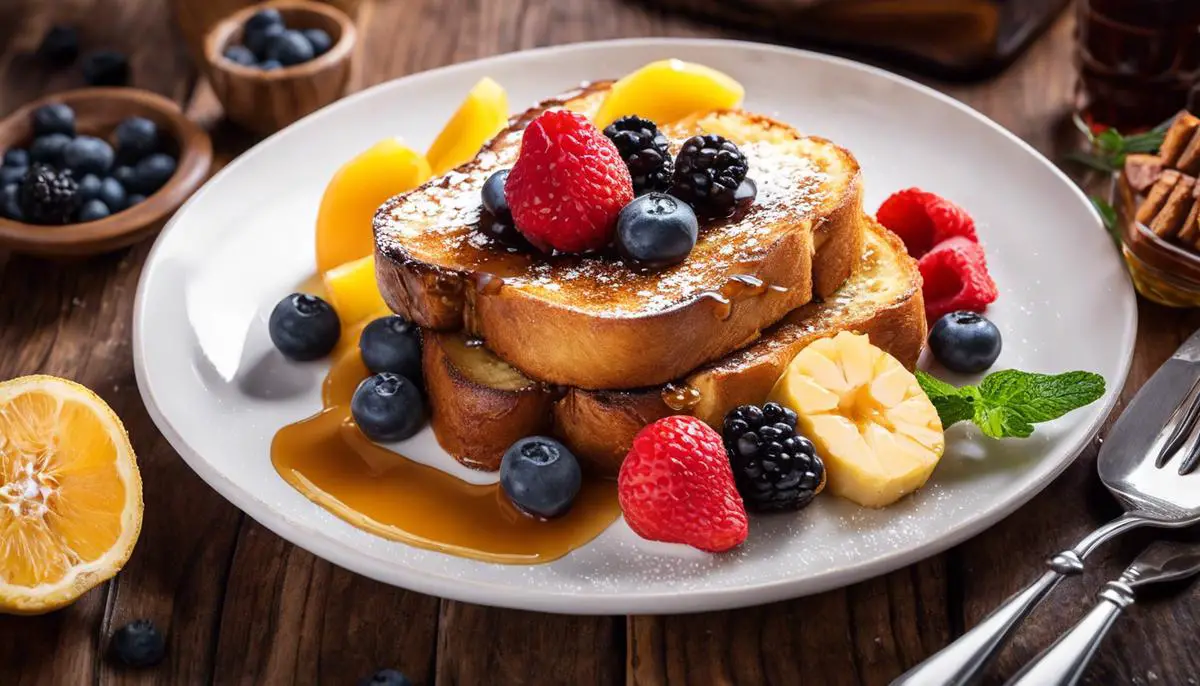
Embarking on the journey of perfecting French toast is to embrace a symphony of flavors and textures, a testament to the simple pleasure of expertly prepared comfort food. From the golden crust kissed by a hot skillet to the final flourish of toppings that adorns each slice, French toast is a narrative of personal taste and culinary exploration. As you set your table with warm plates and anticipate the smiles of your companions, you realize that the joy of French toast goes beyond the meal itself—it’s about savoring the moment, creating memories, and indulging in the wholesomeness of food made with love and intention.



